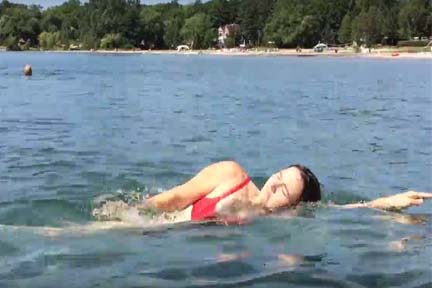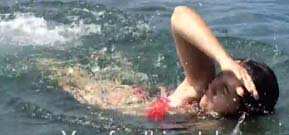If you want to strengthen your spine, the best recommendation you can get is to swim. I’m not talking about getting in the water and going as far as you can using whatever method possible. If you have an injury, you need to understand what technique works for your injury and why, otherwise you could end up creating more harm than good.
Swimming can be relaxing for those who have a basic understanding of the strokes, but if done incorrectly, it could greatly impede your progress to reverse your spinal injury and strengthen your spine.
Let’s look at 5 swim strokes and their impact on your spine:
The Doggy Paddle
Those who doggy paddle tend to do so because they know no other stroke. A lot of children are taught to swim in this way the first year they get in the water. I see a lot of adults swimming this “style” as well.
Staying afloat is the first thing you should learn before getting into technique, however, the  doggy paddle does not teach you how to stay afloat. It teaches you how to get from point A to point B. There are two factors of the doggy paddle that make it easier to sink. Firstly, you become more tired; it requires a lot of effort causing you to breathe more rapidly. In turn, this will lead to less air in the lungs. Secondly, because only beginner swimmers tend to use this stroke, they become tenser whilst trying to swim. This leads to an increase in density in the muscles. It would be like releasing some air out of a balloon and putting in rocks instead.
doggy paddle does not teach you how to stay afloat. It teaches you how to get from point A to point B. There are two factors of the doggy paddle that make it easier to sink. Firstly, you become more tired; it requires a lot of effort causing you to breathe more rapidly. In turn, this will lead to less air in the lungs. Secondly, because only beginner swimmers tend to use this stroke, they become tenser whilst trying to swim. This leads to an increase in density in the muscles. It would be like releasing some air out of a balloon and putting in rocks instead.
As I mentioned before, swimming can be relaxing. But when swimming the doggy paddle, a lot of people believe that the harder they work, the easier it will be to get to the other side. That is where the problems start. You thrust your neck upward (and yes, I’ve seen adults do this too) because you’re afraid of it touching the water for some reason. For this reason, it is a terrible stroke to use when trying to heal a spinal injury.
There’s a reason why this style is called the doggy paddle—it shouldn’t be applied to humans.
Side Glide
This isn’t a stroke but it is a great technique to use before learning how to swim both front and  back strokes. And it is great for the spine! That’s because if done correctly, your head and neck are in line with your spine and it gets gentle resistance from moving through water. Make sure your arm is glued to your ear. Many people think it’s good enough to have your arm glued to your head but that will not ensure correct form. Maybe even turn it into a fun game of making sure you can’t hear anything from one ear as long as you’re in the water. One move away from your ear and it’ll increase the pain you’re experiencing from your injury. So keep your eyes open and that ear closed!
back strokes. And it is great for the spine! That’s because if done correctly, your head and neck are in line with your spine and it gets gentle resistance from moving through water. Make sure your arm is glued to your ear. Many people think it’s good enough to have your arm glued to your head but that will not ensure correct form. Maybe even turn it into a fun game of making sure you can’t hear anything from one ear as long as you’re in the water. One move away from your ear and it’ll increase the pain you’re experiencing from your injury. So keep your eyes open and that ear closed!
Butterfly
Maybe you want to swim like Michael Phelps one day, but not with your injury. Even without an injury, this stroke takes years to perfect. That’s because buoyancy plays no part in getting you forward like most strokes. You rely on a large portion of your muscles—especially your back muscles. This is a problem for people with spinal injuries because without enough muscle, your spine doesn’t have the momentum to go through the motions alone.
injury, this stroke takes years to perfect. That’s because buoyancy plays no part in getting you forward like most strokes. You rely on a large portion of your muscles—especially your back muscles. This is a problem for people with spinal injuries because without enough muscle, your spine doesn’t have the momentum to go through the motions alone.
Front Stroke/Crawl
Just as discussed in the side glide section, this stroke is beneficial to those with spinal injuries because your head is always in line with your spine. Think of it like this: you’re looking at the bottom of the pool for inspiration as to whether you should do your side glide on the right or on the left, then you take a breath after three strokes, and keep looking for your inspiration. Repeat.
because your head is always in line with your spine. Think of it like this: you’re looking at the bottom of the pool for inspiration as to whether you should do your side glide on the right or on the left, then you take a breath after three strokes, and keep looking for your inspiration. Repeat.
Breaststroke
Most adults do some version of this stroke but they exclude the part where their head goes in  the water, giving you time to float forward for a few seconds. That’s fine if you’re just swimming for fun, but with an injury it will irritate your spine to not take that floating break. The break allows the water to gently push against the spine, giving it a soft massage. Try it out!
the water, giving you time to float forward for a few seconds. That’s fine if you’re just swimming for fun, but with an injury it will irritate your spine to not take that floating break. The break allows the water to gently push against the spine, giving it a soft massage. Try it out!
In summary:
What you should do — side glide, front crawl, and breaststroke
What you shouldn’t do — doggy paddle and butterfly
Final thoughts:
It’s easy to sign up for lessons at your town’s local recreation centre, but in this case, it’s smarter to do your research and find a program that corresponds to your needs. Local recreational programs often cater to the average person. The instructors are qualified for the curriculum of the course, not for advanced anatomical problems.
Swim clubs on the other hand focus on fitness, intensity, and speed. They are great to join after you’ve fixed your injuries. What good is swimming nearly as fast as Michael Phelps if you’re damaging your spine along the way? (Trick question—you can’t swim as fast as Michael Phelps with incorrect technique)
Focus on what you are looking for. Find a program that not only has a qualified instructor, but an experienced instructor who has worked with people in your situation. If you have your own pool, that’s great! Get to swimming, and if you have any questions on how to use proper technique, just give us a shout.